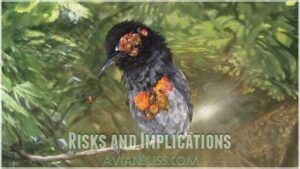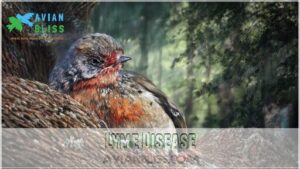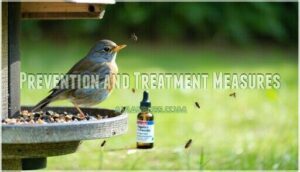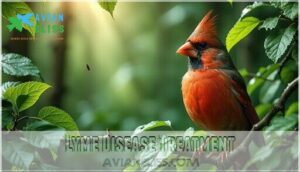This site is supported by our readers. We may earn a commission, at no cost to you, if you purchase through links.

You’ll find these tiny parasites clinging to robins, warblers, and countless other species in your backyard and beyond.
Birds actually serve as perfect hosts for ticks, providing warm blood meals and transportation across vast distances.
Some bird species carry more ticks than others, depending on their feeding habits and where they nest.
Ground-feeding birds like thrushes tend to pick up more ticks than birds that stay in treetops.
What’s particularly concerning is that infected birds can transport disease-carrying ticks hundreds of miles during migration, creating a natural highway for Lyme disease and other tick-borne illnesses.
Understanding which species are tick magnets reveals surprising patterns about disease spread.
Table Of Contents
Key Takeaways
- You’ll find ticks on over 90 bird species, with ground-feeding birds like Purple Finches and thrushes carrying the highest loads due to their foraging habits in tick-rich leaf litter.
- Birds act as "tick taxis" during migration, transporting disease-carrying ticks hundreds of miles and establishing new Lyme disease hotspots wherever they land.
- Tick infestations harm birds through blood loss and anemia, with heavy loads causing weakness, behavioral changes like excessive preening, and reduced survival rates in nestlings.
- You can protect birds and yourself by removing leaf litter and tall grass around your property, maintaining 3-foot barriers around bird areas, and conducting regular tick checks on any birds you manage.
Do Birds Get Ticks?
Yes, birds absolutely get ticks, and these tiny parasites can substantially impact both wild and pet birds’ health.
Over 90 bird species carry ticks and the bacteria that causes Lyme disease, with ground-feeding birds like Purple Finches showing particularly high infestation rates, which can be a significant concern for the health of these birds.
Tick Infestation on Birds
Yes, birds can get ticks, creating significant health challenges.
These avian parasites cause tick burden and feather damage, leading to anemia risk from blood loss.
Ground-feeding species like Purple Finches show higher tick infestation rates, with behavioral changes including excessive preening.
Nestling impact proves especially severe, affecting survival rates.
Birds can also experience discomfort from fleas and mites.
Birds and ticks share complex relationships, where avian ticks act as both bird parasites and disease vectors, making ticks on birds a serious ecological concern requiring careful monitoring.
Prevalence of Ticks on Birds
Tick burden on birds continues rising, with infestation rates climbing due to milder winters that help these parasites survive. Geographic variation shows ticks concentrated in the Northeast, Midwest, and California, though migratory birds are spreading them nationwide.
Seasonal trends reveal peak activity during warmer months when both bird species and ticks are most active. Bird parasites like ticks create a complex web of transmission.
Over 90 bird species can carry ticks and Lyme disease bacteria, making avian ticks a significant concern for public health. Understanding these patterns helps predict where ticks affecting birds might establish next.
Here’s what you’ll observe in nature:
- Ground-feeding birds show higher tick loads than canopy dwellers
- Purple Finches and true thrushes carry more ticks than other species
- Migratory songbirds transport ticks across vast distances, establishing new populations
Risks and Implications
While you might assume songbirds chirping in your backyard are tick-free, certain species actually serve as unwitting carriers that can substantially impact disease transmission patterns.
Understanding which bird species pose higher risks helps you make informed decisions about wildlife management and personal protection strategies.
High-Risk Bird Species
Machine learning has identified which bird species you should watch out for regarding ticks affecting birds and disease transmission.
Ground-foraging birds like American robins and ground nesting birds face the highest risk due to their feeding habits in leaf litter where ticks lurk.
Passerine tick vectors, particularly songbirds ticks carriers from the Thrush Lyme Risk category, show concerning infection rates.
Seed-eater spread patterns make these species priority targets for bird surveillance priorities since they frequent backyard feeders near homes.
Traits of Lyme-Competent Bird Species
When ground-foraging Passerine Risk Factors come together, certain Avian Lyme Reservoirs become efficient disease spreaders.
Songbirds ticks particularly affect species with low baseline corticosterone levels and high-latitude breeding habits. Ground Foragers like the Turdus Genus members excel at picking up infected ticks from leaf litter.
Their Seed Eater Role keeps them close to tick-rich undergrowth, while broad distribution ranges help spread tickborne diseases. These traits create perfect conditions for birds get Lyme disease scenarios, making certain species nature’s unwitting disease couriers across vast territories.
A balanced diet aids in strengthening their immune system to combat such infestations.
Implications for Human Health
Understanding which bird species spread tickborne diseases directly impacts your health and safety.
Disease prediction models help identify high-risk areas, enabling public health officials to implement targeted vector surveillance programs.
Here’s how birds spreading ticks affects you:
- Early diagnosis becomes possible when doctors know Lyme disease hotspots
- Treatment strategies improve with better geographic disease mapping
- Prevention efforts focus on areas where infected birds migrate
- Public health responses activate faster in predicted outbreak zones
When climate shifts alter bird migration patterns, new regions face increased disease transmission risks, making proactive monitoring essential for protecting human health.
Bird Role in Tickborne Disease
Understanding how birds contribute to tick-borne disease spread has become increasingly important for predicting and preventing outbreaks.
Recent machine learning research has identified specific bird species that act as "tick taxis," helping scientists create targeted surveillance systems for diseases like Lyme.
Study Overview
Researchers developed breakthrough predictive models using machine learning to tackle the question "do birds carry ticks?"
Their interdisciplinary approaches achieved 80% model accuracy in identifying birds that spread Lyme disease to ticks.
This innovative species prioritization method flagged 21 high-risk species for tickborne disease surveillance, revolutionizing our understanding of zoonotic diseases and bird tick prevention strategies.
These high-risk species often exhibit low corticosterone levels.
Future Applications
You’ll see exciting advances in disease modeling as this technology expands beyond Lyme disease.
Here’s how predictive surveillance will transform public health:
- Zoonotic diseases like COVID-19 can be tracked using similar bird surveillance methods
- Climate impacts on migration patterns will help predict tickborne disease spread to new regions
- Disease prevention strategies will target high-risk species for better disease control
This approach revolutionizes disease management through data-driven insights.
Tick Life Cycle and Transmission
You’ll find that understanding the tick life cycle helps explain how these parasites spread disease between birds and humans.
Lyme disease transmission happens when infected ticks feed on birds, then later bite people during their next blood meal, which is a key factor in the spread of Lyme disease.
Lyme Disease
Lyme disease strikes when infected deer ticks transmit Borrelia burgdorferi bacteria into your bloodstream.
Birds serve as essential Lyme reservoirs, carrying infected bird ticks across vast distances and introducing tickborne diseases to new areas. Early Lyme diagnosis proves challenging since symptoms mimic flu-like illness. One should also be aware that birds can be affected by other parasites, such as red mites causing anemia.
Key facts about Lyme disease:
- Early symptoms – Bulls-eye rash, fever, headache, and muscle aches
- Late symptoms – Joint pain, heart problems, and neurological issues
- Lyme vectors – Deer ticks are primary carriers, but bird ticks also transmit
- Lyme prevention – Wear long sleeves, use repellent, check for ticks
- Treatment window – Antibiotics work best within 72 hours of bite
- Geographic spread – Migratory birds expand disease range annually
Lyme disease treatment becomes more complex when delayed, making prevention your best defense.
Tick Life Cycle
Complexity defines the tick life cycle, which spans two years for deer ticks.
You’ll find these parasites progressing through distinct stages: Larval Stage parasites feed on small mammals like mice, while Nymphal Stage ticks target birds and humans.
Adult Ticks prefer larger hosts including deer and dogs.
The Molting Process occurs between each stage, allowing growth and development.
Tick Reproduction happens when adults mate on hosts.
Different tick species occupy various tick habitats, affecting tick distribution patterns.
This intricate tick ecology directly impacts disease transmission, making each stage essential for understanding pathogen spread.
Prevention and Treatment
You’ll want to protect both yourself and birds from tick exposure through smart prevention strategies.
If ticks do latch onto birds, quick removal and proper treatment can prevent serious health complications.
Prevention and Treatment Measures
Managing tick exposure in birds requires a multifaceted approach combining environmental control with targeted treatments. You’ll want to focus on habitat management first, removing leaf litter and tall grass that create tick havens around your property.
Key Prevention Strategies:
- Environmental Controls – Establish 3-foot gravel or wood chip barriers around bird areas, maintain regular mowing, and eliminate debris that harbors ticks.
- Tick Repellents and Treatments – Apply bird-safe repellent treatments containing DEET or picaridin to managed areas, using veterinary-approved spot-on medications for direct bird tick control.
- Regular Checks and Monitoring – Conduct routine inspections of your birds, focusing on neck, wing, and eye areas where ticks commonly attach during feeding.
- Professional Veterinary Consultation – Work with avian veterinarians for safe removal techniques and bird tick treatment protocols, as improper tick removal birds can cause injury.
Effective tick control methods are vital for protecting birds from tick-borne diseases.
This integrated approach guarantees effective tick prevention while protecting your feathered friends.
Lyme Disease Treatment
Quick action saves lives when Lyme disease strikes. If you suspect infection after tick exposure, don’t wait—early antibiotic regimens like doxycycline work best within 72 hours.
Your doctor will assess lyme disease symptoms including the telltale bullseye rash, fever, and joint aches. Standard tick treatment options involve 10-21 day courses of antibiotics.
While chronic lyme remains controversial, some patients develop post-treatment syndrome requiring longer care. Alternative therapies show mixed results, though emerging treatments offer hope.
For pet birds showing tickborne infections, consult an avian veterinarian immediately—proper tick removal techniques prevent complications. Birds may also exhibit feather abnormalities due to parasitic infections.
Frequently Asked Questions (FAQs)
Do birds spread tick borne disease?
Birds absolutely serve as flying superhighways for tickborne diseases.
You’re right to worry – over 90 bird species carry ticks and Lyme bacteria.
Their migrations transport infected ticks across vast distances, establishing new disease hotspots wherever they land, making them a key factor in the spread of tickborne diseases.
Do birds carry ticks?
Yes, you’ll find that birds absolutely carry ticks. Over 90 bird species transport these parasites, with ground-feeding and migratory birds acting as perfect "tick taxis" that spread them across vast distances.
Are birds susceptible to ticks?
Absolutely, birds are highly susceptible to ticks and serve as common hosts. Over 90 bird species carry ticks, with ground-feeding and seed-eating birds experiencing higher infestation rates than others.
Can birds get fleas and ticks?
Feathered friends can definitely pick up both fleas and ticks during their daily adventures.
You’ll find ticks more commonly on birds, especially ground-feeders, while ticks prefer mammals but occasionally hitchhike on birds too.
Do birds spread Lyme to ticks?
You’ll find that infected birds don’t directly spread Lyme disease to ticks. Instead, birds carry Borrelia burgdorferi bacteria and infect ticks when they feed on infected blood.
Do birds eat ticks?
Birds absolutely devour ticks like nature’s tiny vacuum cleaners.
You’ll find many species, especially ground-feeders like robins and thrushes, actively hunting these parasites as protein-rich snacks during their daily foraging adventures.
Do backyard birds carry ticks?
Yes, your backyard birds regularly carry ticks that can spread diseases like Lyme. Ground-feeding species like finches, thrushes, and seed-eaters have higher tick loads than other birds.
Do birds get bitten by ticks?
Like knights of old battling bloodsucking foes, ticks absolutely bite birds.
You’ll find these parasites attaching to feathers and skin, feeding on blood for days.
They cause anemia, transmit diseases like Lyme, and weaken birds substantially.
Do ticks harm birds?
Ticks absolutely harm birds through blood loss, disease transmission, and reduced reproductive success.
You’ll find heavy infestations cause anemia, weakness, and increased predator vulnerability, while tick-borne pathogens create serious health complications.
Do birds get fleas and ticks?
Feathered creatures absolutely pick up both fleas and ticks during their daily adventures.
You’ll find ticks more commonly than fleas on wild birds, especially ground-feeders who encounter these parasites in grass and brush.
Conclusion
Think of migrating birds as nature’s unwitting taxi service—they’re basically providing free rides to hitchhiking ticks across continents.
Research shows that some songbirds carry up to 100 ticks during peak migration seasons.
Understanding that birds do get ticks isn’t just academic curiosity; it’s vital for predicting disease outbreaks.
Ground-feeding species like thrushes remain the primary carriers, while their migration patterns directly influence where Lyme disease emerges next.
Monitoring bird-tick relationships helps scientists forecast health risks in your community.
- https://pmc.ncbi.nlm.nih.gov/articles/PMC4914531/
- https://vetmed.tamu.edu/news/press-releases/study-shows-migratory-songbirds-can-carry-ticks-into-the-united-states/
- https://pipd.ncipd.org/index.php/pipd/article/view/48-3-6_role_of_birds_in_transmission_of_lyme
- https://www.freethink.com/health/lyme-disease-spread
- https://www.caryinstitute.org/news-insights/press-release/new-study-identifies-bird-species-could-spread-ticks-and-lyme-disease









